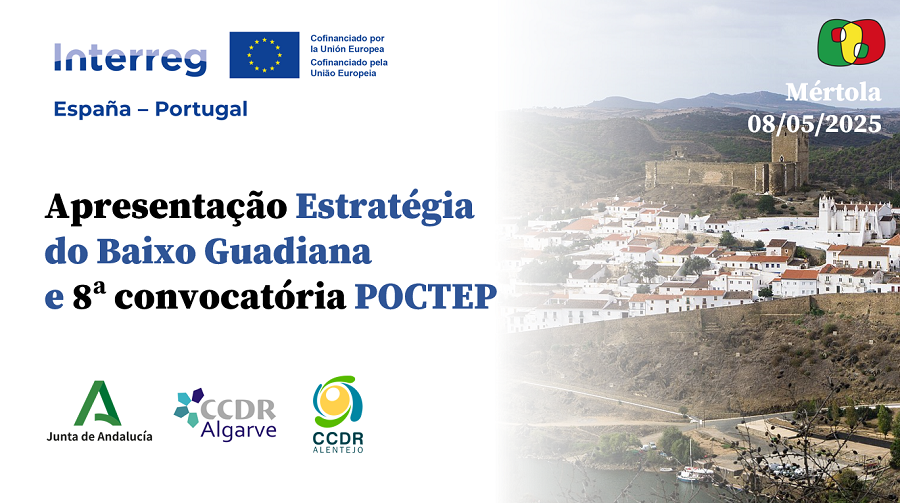On 8 May 2025, in Mértola, the Framework Strategy for Cross-Border Action to Promote the Socioeconomic Development of the Guadiana River Strip – Lower Guadiana was officially presented. This important planning tool, developed through a participatory process within the framework of the Interreg POCTEP OP5 BAJO GUADIANA project under the coordination of the Regional Government of Andalusia and the Regional Coordination and Development Commissions of Alentejo and Algarve, aims to boost cross-border socioeconomic development in this key area of the Guadiana River.
The strategy, co-financed by the European Union through the Interreg Spain-Portugal (POCTEP) 2021–2027 Programme, falls within the scope of cross-border cooperation in the Alentejo-Algarve-Andalusia (AAA) Euroregion. This territory shares a natural border and common geographical, economic, social, historical, and cultural characteristics, which favour cooperation. The AAA Euroregion seeks to foster knowledge and mutual understanding among its populations, promote joint initiatives, encourage dialogue and cooperation between public and private entities, strengthen international competitiveness, and support sustainable development in a region with great potential, but also significant challenges.
This strategy serves as the starting point for the 8th POCTEP project call, the key (still provisional) points of which were also presented at the event.
What the Lower Guadiana Strategy Involves
The strategy’s area of influence covers 4,251 km², including municipalities in Huelva (47.5%), the municipality of Mértola in Baixo Alentejo (30.4%), and the municipalities of Alcoutim, Castro Marim, and Vila Real de Santo António in the Algarve (22.0%). This region presents a marked duality between the coastal areas, where most economic activity and population are concentrated, and the rural inland areas, which face challenges such as depopulation and ageing.
The strategy was developed through a participatory process conducted in March and April 2023, involving key stakeholders from across the territory (social, economic, and environmental) to gather their insights and knowledge. This process led to the definition of six Strategic Axes, which form the basis of the action plan.
The Six Strategic Axes of the Lower Guadiana Strategy:
1. Navigability of the River Guadiana
Aims to revitalise the river as a driving force by improving infrastructure and extending the navigable stretch, especially up to Mértola. This aligns with Challenge 15 (blue economy) and Challenge 17 (river-related infrastructure) of the AAA Euroregion Strategy.
2. Sustainable River-Linked Economy
Focuses on improving business competitiveness, encouraging entrepreneurship, diversifying the tourism offer beyond sun and beach (e.g. nautical, sports, and nature tourism), strengthening fisheries inspection and sustainable aquaculture, enhancing traditional salt production, and exploring the mining potential of the Iberian Pyrite Belt. It directly contributes to Challenges 1 (business dimension), 3 (economic recovery), and 15 (blue economy) of the AAA Euroregion.
3. Biodiversity Conservation and Rural Space Valorisation
Prioritises the protection of areas like the Natura 2000 Network, which covers almost 40% of the Lower Guadiana. Includes actions such as land stewardship, conservation of vulnerable species and habitats (e.g. the lesser kestrel), environmental awareness, sustainable land management, support for local agri-food products, and protection of traditional species’ genetic heritage, such as the olive tree. Contributes to Challenges 14 (biodiversity) and 11 (climate change) of the AAA Euroregion.
4.Risk Management, Climate Change, and Desertification
Addresses the expected impacts of climate change, such as rising temperatures, droughts, heavy rainfall, and increased wildfire risk. Proposes mechanisms to implement adaptation strategies, promote renewable energy, and encourage urban green infrastructure. Aims to foster knowledge and prevention regarding climate risks. This axis aligns with Challenges 11 (climate change) and 12 (emissions and energy efficiency) of the AAA Euroregion.
5.Culture and Heritage
Focuses on the preservation, rehabilitation, and promotion of the rich historical and cultural heritage of the Lower Guadiana. Actions include the creation of new cultural and heritage routes, the promotion of intangible heritage (crafts, festivals, music, dance, gastronomy, such as the smuggling route and its associated festival), and the encouragement of cross-border gatherings. Contributes to Challenge 10 (heritage and culture) of the AAA Euroregion.
6.Quality of Life and Cooperation Between Citizens and Institutions
Aims to improve cross-border accessibility (roads, public transport, pedestrian and cycle mobility), strengthen institutional capacity, and promote multilingualism. Encourages cooperation in social services and support for vulnerable groups, including seasonal migration. It particularly builds on existing cooperation structures such as the Guadiana Eurocity (Ayamonte, Castro Marim, Vila Real de Santo António). It aligns with Challenges 4 (bilingual education), 16 (transport infrastructure), 18 (quality of life and social services), and 20 (cross-border governance) of the AAA Euroregion.





